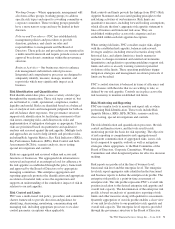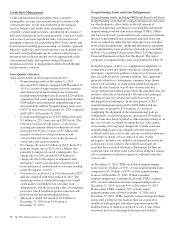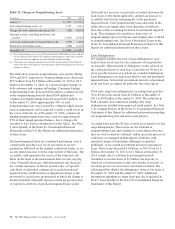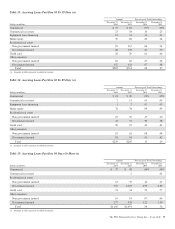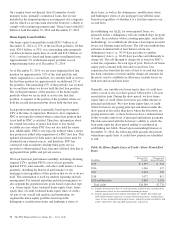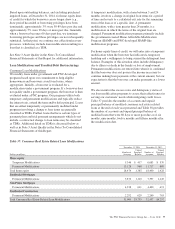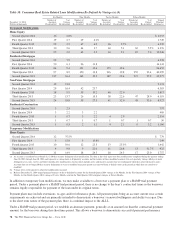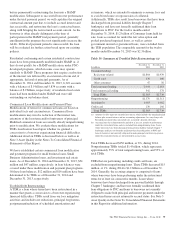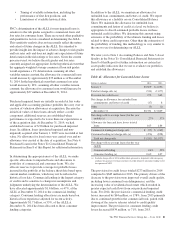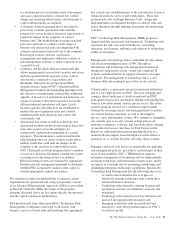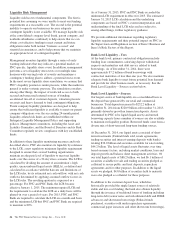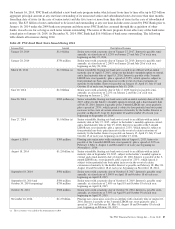PNC Bank 2014 Annual Report Download - page 97
Download and view the complete annual report
Please find page 97 of the 2014 PNC Bank annual report below. You can navigate through the pages in the report by either clicking on the pages listed below, or by using the keyword search tool below to find specific information within the annual report.
before permanently restructuring the loan into a HAMP
modification. Subsequent to successful borrower performance
under the trial payment period, we will capitalize the original
contractual amount past due, to include accrued interest and
fees receivable, and restructure the loan’s contractual terms,
along with bringing the restructured account current. As the
borrower is often already delinquent at the time of
participation in the HAMP trial payment period, generally
enrollment in the program does not significantly increase the
ALLL. If the trial payment period is unsuccessful, the loan
will be evaluated for further action based upon our existing
policies.
Residential conforming and certain residential construction
loans have been permanently modified under HAMP or, if
they do not qualify for a HAMP modification, under PNC-
developed programs, which in some cases may operate
similarly to HAMP. These programs first require a reduction
of the interest rate followed by an extension of term and, if
appropriate, deferral of principal payments. As of
December 31, 2014 and December 31, 2013, 6,349 accounts
with a balance of $.9 billion and 5,834 accounts with a
balance of $.9 billion, respectively, of residential real estate
loans had been modified under HAMP and were still
outstanding on our balance sheet.
Commercial Loan Modifications and Payment Plans
Modifications of terms for commercial loans are based on
individual facts and circumstances. Commercial loan
modifications may involve reduction of the interest rate,
extension of the loan term and/or forgiveness of principal.
Modified commercial loans are usually already nonperforming
prior to modification. We evaluate these modifications for
TDR classification based upon whether we granted a
concession to a borrower experiencing financial difficulties.
Additional detail on TDRs is discussed below as well as in
Note 3 Asset Quality in the Notes To Consolidated Financial
Statements of this Report.
We have established certain commercial loan modification
and payment programs for small business loans, Small
Business Administration loans, and investment real estate
loans. As of December 31, 2014 and December 31, 2013, $34
million and $47 million, respectively, in loan balances were
covered under these modification and payment plan programs.
Of these loan balances, $12 million and $16 million have been
determined to be TDRs as of December 31, 2014 and
December 31, 2013, respectively.
Troubled Debt Restructurings
A TDR is a loan whose terms have been restructured in a
manner that grants a concession to a borrower experiencing
financial difficulties. TDRs result from our loss mitigation
activities and include rate reductions, principal forgiveness,
postponement/reduction of scheduled amortization and
extensions, which are intended to minimize economic loss and
to avoid foreclosure or repossession of collateral.
Additionally, TDRs also result from borrowers that have been
discharged from personal liability through Chapter 7
bankruptcy and have not formally reaffirmed their loan
obligations to PNC. For the twelve months ended
December 31, 2014, $1.2 billion of Consumer loans held for
sale, loans accounted for under the fair value option and
pooled purchased impaired loans, as well as certain
government insured or guaranteed loans, were excluded from
the TDR population. The comparable amount for the twelve
months ended December 31, 2013 was $2.3 billion.
Table 39: Summary of Troubled Debt Restructurings (a)
In millions
December 31
2014
December 31
2013
Consumer lending:
Real estate-related $1,864 $1,939
Credit card 130 166
Other consumer 47 56
Total consumer lending 2,041 2,161
Total commercial lending 542 578
Total TDRs $2,583 $2,739
Nonperforming $1,370 $1,511
Accruing (b) 1,083 1,062
Credit card 130 166
Total TDRs $2,583 $2,739
(a) Amounts in table represent recorded investment, which includes the unpaid principal
balance plus accrued interest and net accounting adjustments, less any charge-offs.
Recorded investment does not include any associated valuation allowance.
(b) Accruing loans have demonstrated a period of at least six months of performance
under the restructured terms and are excluded from nonperforming loans. Loans
where borrowers have been discharged from personal liability through Chapter 7
bankruptcy and have not formally reaffirmed their loan obligations to PNC and
loans to borrowers not currently obligated to make principal and interest payments
under the restructured terms are not returned to accrual status.
Total TDRs decreased $156 million, or 6%, during 2014.
Nonperforming TDRs totaled $1.4 billion, which represents
approximately 55% of total nonperforming loans, and 53% of
total TDRs.
TDRs that are performing, including credit card loans, are
excluded from nonperforming loans. These TDRs decreased $15
million, or 1%, during 2014 to $1.2 billion as of December 31,
2014. Generally, the accruing category is comprised of loans
where borrowers have been performing under the restructured
terms for at least six consecutive months. Loans where
borrowers have been discharged from personal liability through
Chapter 7 bankruptcy and have not formally reaffirmed their
loan obligations to PNC and loans to borrowers not currently
obligated to make both principal and interest payments under the
restructured terms are not returned to accrual status. See Note 3
Asset Quality in the Notes To Consolidated Financial Statements
in this Report for additional information.
The PNC Financial Services Group, Inc. – Form 10-K 79




